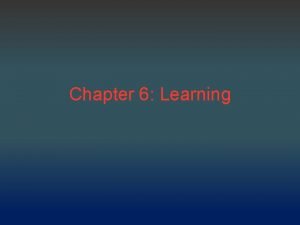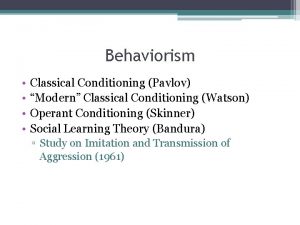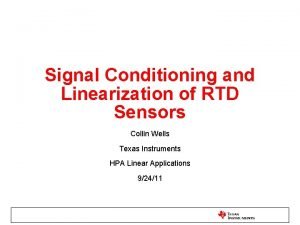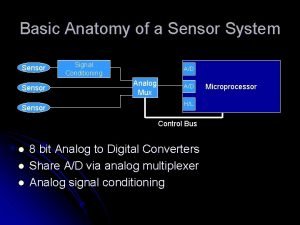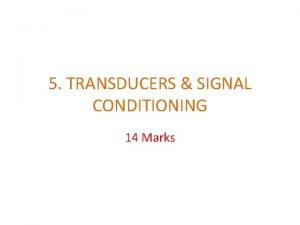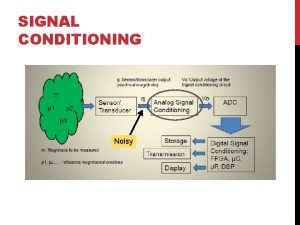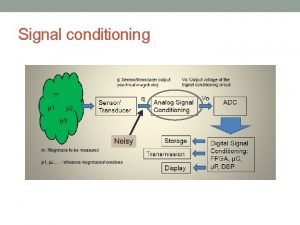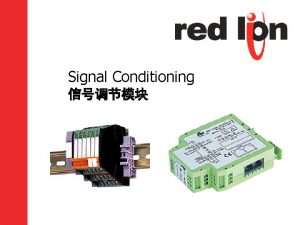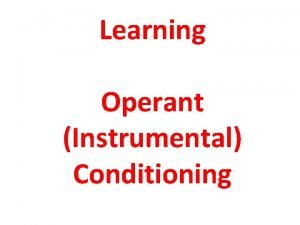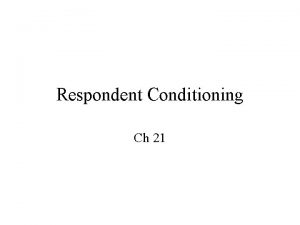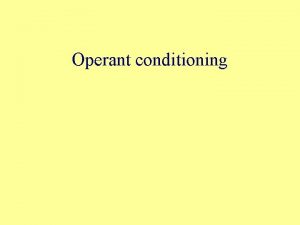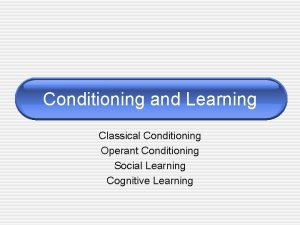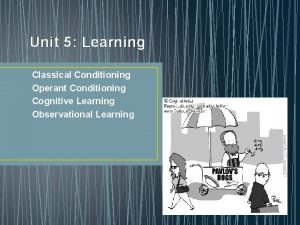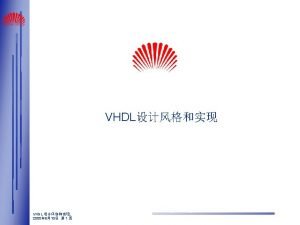Unit 6 Signal Conditioning Unit 6 Signal Conditioning

















- Slides: 17

Unit 6 Signal Conditioning

Unit 6 Signal Conditioning

Unit 6 Signal Conditioning The full-scale outputs of most sensors (passive or active) are relatively small voltages, currents, resistances and capacitances. Before further analog or digital processing can take place, these outputs must be scaled or converted to useful ranges. 句中full-scale意为“满量程”,passive sensor意为“ 被动型传感器”或“无源传感器”,active sensor意为 “主动型传感器”或“有源传感器”,scale在这里指“ 换算缩放,改变值的大小”。 译为:绝大多数传感器(无源或有源)的满量程输出都是 比较小的电压、电流、电阻和电容。在进行进一步模拟或 数字信号处理之前,这些输出必须要换算缩放或转换到可 用的范围。

Unit 6 Signal Conditioning Signal conditioning circuits perform the necessary amplification, level translation, impedance transformation, linearization and filtering. The characteristics of and error in the sensor output determine the type of signal conditioning circuits needed. 信号调理电路实现必要的信号放大、电平变换、阻抗 变换、线性化和滤波。传感器的特性和误差决定了所需信 号调理电路的类型。

Unit 6 Signal Conditioning If the sensor output is not conditioned properly, factors such as sensitivity, voltage and current levels, linearity(线性度,线性) , impedances, gain, offset, drift, time constants, maximum electrical ratings(最大额定电功率), stray impedances(杂 散阻抗,寄生阻抗)and other important considerations can impact the overall performance of the sensor. As a result, the overall system will suffer, particularly when high resolution, precision or very low level measurements are involved. 如果传感器输出没有经过适当调理,像灵敏度、电压电流 水平、线性度、阻抗、增益、偏移、漂移、时间常数、最 大电功率、杂散阻抗及其他重要的考虑因素会影响传感器 的综合性能。最终,整个系统精确度会变差或测量水平很 低,尤其是在高分辨率时。

Unit 6 Signal Conditioning Voltage output Three types of input topologies exist for the signal conditioning of voltage output sensors: differential, singleended and pseudo-differential. The type of signal conditioning input is typically matched to the output structure and precision requirements of the sensor. 句中differential有“微分”和“差分”之意,这里指 信号处理的方式,意为“差动”。 译为:电压输出传感器的信号调理有3种输入拓扑方式: 差动方式、单端方式和准差分方式。信号调理电路的输入 类型要与传感器的输出结构和精度要求相匹配。

Unit 6 Signal Conditioning A differential device rejects input signals common to the balanced input pair (+ and -) while accepting the difference between the input signals, specified as the Common-Mode Rejection Ratio (CMRR). The device is designed so that the noise common to both inputs is rejected while the signal of interest is not. 句中balanced input意为“对称输入”,Common. Mode Rejection Ratio (CMRR)意为“共模抑制比”。 译为:差动装置在接收两输入端口的差分信号时,抑制 这两个对称输入端口(+和-)的共模输入信号,这称为 共模抑制比(CMRR)。这样设计抑制输入端的共模噪音, 而不抑制有用信号。

Unit 6 Signal Conditioning This type of input topology(拓扑,拓扑结构,布局,拓扑 学)is used when maximum noise rejection is required and the sensor measurement is not tied to ground, as with the Wheatstone bridge(惠斯顿电桥)configuration. For remote sensor applications, shielded twisted pair cables(双绞线) should be used in order to maintain signal balance and share a common ground reference. 当要求最大噪音抑制和传感器没有接地时,就要用惠斯顿 电桥来实现这种输入拓扑形式,对远程传感器应用,应该 使

Unit 6 Signal Conditioning Finally, a pseudo-differential input topology is a hybrid of the two. Its DC offset performance approaches that of a differential device, but its CMRR is closer to a SE device. This type of device is used in cost-sensitive designs with DC sensors where high frequency variations from noise can be removed at the end of the signal chain or through digital processing. 句中DC是direct current的缩写,意为“直流电”。 最后,准差分输入拓扑形式是前两种方式的混合。它 的直流(DC)偏移特性接近于差分设备,但共模抑制( CMRR)比更接近于单端设备。这种类型的装置用于有直流 传感器的代价敏感的设计中,这种装置能在信号链的终端 或通过数字信号处理去除噪声的高频变化。

Unit 6 Signal Conditioning For very low-level input signals, multiple levels of amplification and high gains are sometimes required. Because of the operational amplifier’s(运算放大器)architecture, input offset voltage and input bias(偏差,偏移,偏置) current can add error to the amplifier’s input. 对于低电平输入信号,有时需要多级放大和高增益。由 于运算放大器的结构原因,输入偏移电压和输入偏差电 流会增加放大器输入的误差。

Unit 6 Signal Conditioning Non-ideal features of operational amplifiers: 运算放大器的非理想特性: Voltage Offset电压偏移 Input Bias Current: 输入偏移电流 Common Mode Rejection: 共模抑制

Unit 6 Signal Conditioning Noise Sensor signals running long distances over wire and cable essentially become antennas, picking up electrical and magnetic interference from many RF sources. Ground loops( 地回路,接地环路)on single-ended signals can also significantly raise/lower the noise potential of a sensor signal with respect to the signal conditioning circuits. 传感器信号经必要的导线或电缆远距离传输,必然变 得像天线一样,容易受到许多射频源的电磁干扰。在信号 调理电路中,单端信号的接地环路能有效降低传感器信号 中的噪音电位。

Unit 6 Signal Conditioning Isolation circuits are created by taking advantage of electric and magnetic field properties in structures such as transformers, capacitors, photoelectric devices and RF signal propagation to transmit data across an interface without a physical connection. 隔离电路利用变压器、电容器、光电元件和RF信号发 射元件等构件中的电磁原理制成,以在无物理连接的界面 间传送数据。

Unit 6 Signal Conditioning Filtering Passive analog filters use discrete components such as capacitors, inductors and resistors. Active analog filters use discrete components in conjunction with operational amplifiers for a more precise filter design. 句中Passive analog filters指“被动模拟滤波器”,也 称无源滤波器。Active analog filters指“主动模拟滤 波器”,也称有源滤波器。 全句译为:无源模拟滤波器由电容、电感和电阻这样的独 立元件构成。有源模拟滤波器将这些独立元件连接在运算 放大器上,得到更高的设计精度。

Unit 6 Signal Conditioning Filters, whether active or passive, can be broken down into three basic functional areas: low-pass filters, high-pass filters and bandpass filters. Low-pass filters (LPFs)(低通滤波器) only allow electrical signals under a determined frequency to pass through, often called the cut-off frequency. High-pass filters (HPFs)(高通滤波器)allow electrical signals to pass though that is above the cut-off frequency. 滤波器,无论是有源的还是无源的,都能分成 3种基 本功能:低通滤波器,高通滤波器和带通滤波器。低通滤 波器(LPFs)只允许低于指定频率的电信号通过,常称为截 止频率。高通滤波器(HPFs)允许高于截止频率的电信号通 过。

Unit 6 Signal Conditioning Analog-to-analog conversion Some primary elements convert changes in the measured variable into small changes in resistance. Strain gages(应变仪) and resistance temperature detectors (RTDs) are two examples. A bridge circuit is often used to convert the change in resistance into a small change in voltage. This small voltage is then amplified and converted to an electric current signal suitable for use by the controller。 注意句中changes强调转换的不是被测量本身,而是被测 量的“变化量”。 一些基本元件将被测量的变化量转换成电阻的很小的变 化量。应变片和电阻式温度探测器(RTDs)就是两个例子。电 桥常用于将电阻的变化量转换成很小的电压变化量。然后小 电压被放大,转换成适合控制器使用的电流信号。

Unit 6 Signal Conditioning Current output If the output of a sensor is a current, a current-to-voltage converter is often used。A common example is a photodiode (光敏二极管,光电二极管 ) light sensor. An operational amplifier circuit, also known as a transimpedance amplifier( 互阻抗放大器,跨阻抗放大器), can be used to amplify the signal and convert the current through the diode(二极管) to a voltage. 如果传感器的输出是电流,常用到电流-电压转换器。 常见的例子是光电二极管光传感器。运算放大电路,也称 为转阻放大器,能用于放大信号,通过二极管将电压转换 为电流。
 Classical conditioning vs operant conditioning
Classical conditioning vs operant conditioning Generalization psychology
Generalization psychology Classical and operant conditioning
Classical and operant conditioning Classical conditioning and operant conditioning
Classical conditioning and operant conditioning Classical and operant conditioning.
Classical and operant conditioning. Apparent conditioning
Apparent conditioning Fixed-ratio schedule example
Fixed-ratio schedule example Instrumental learning vs classical conditioning
Instrumental learning vs classical conditioning Classical conditioning vs operant conditioning
Classical conditioning vs operant conditioning Operant conditioning classical conditioning
Operant conditioning classical conditioning Rtd signal conditioning
Rtd signal conditioning Signal conditioning
Signal conditioning Signal conditioning
Signal conditioning Signal conditioning definition
Signal conditioning definition Signal conditioning
Signal conditioning Baseband signal and bandpass signal
Baseband signal and bandpass signal Baseband signal and bandpass signal
Baseband signal and bandpass signal Digital signal as a composite analog signal
Digital signal as a composite analog signal







